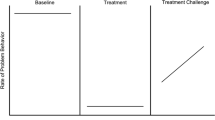Abstract
Response interruption is a common intervention for problem behavior maintained by automatic reinforcement, but this intervention is challenging for caregivers to implement with consistent fidelity. In the current study, we challenged the integrity of response interruption across two participants by examining carry over into conditions in which the procedure was not implemented, by removing the presence of an interventionist, and by introducing delays to implementation. The results indicated that these challenges severely compromised treatment efficacy. Conditions under which response interruption procedures are likely to be effective and possible strategies to increase the effectiveness of response interruption are discussed.
Similar content being viewed by others
References
Ahearn, W. H., Clark, K. M., MacDonald, R. P. F., & Chung, B. I. (2007) Assessing and treating vocal stereotypy in children with autism. Journal of Applied Behavior Analysis, 40, 263–275.
Baron, A., Kaufman, A., & Fazzini, D. (1969). Density and delay of punishment of free—operant avoidance. Journal of the Experimental Analysis of Behavior, 12, 1029–1037.
Fisher, W., Lindover, S. E., Alterson, C. J. & Thompson, R. H. (1998). Assessment and treatment of destructive behavior maintained by stereotypic object manipulation. Journal of Applied Behavior Analysis, 31, 513–527.
Fisher, W. W., Kuhn, D. E., Thompson, R. H. (1998). Establishing discriminative control of responding using functional and alternative reinforcers during functional communication training. Journal of Applied Behavior Analysis, 31, 543–560.
Fisher, W. W., Piazza, C. C., Bowman, L. G., & Amari, A. (1996). Integrating caregiver report with a systematic choice assessment. American Journal on Mental Retardation, 101, 15–25.
Fisher, W., Piazza, C. C., Bowman, L. G., Hagopian, L. P., Owens, J. C., & Slevin, I. (1992). A comparison of two approaches for identifying reinforcers for persons with severe and profound disabilities. Journal of Applied Behavior Analysis, 25, 491–498.
Fisher, W. W., Thompson, R. H., Hagopian, L. P., Bowman, L. G., & Krug, A. (2000). Facilitating tolerance of delayed reinforcement during functional communication training. Behavior Modification, 24, 3–29.
Goodall, G. (1984). Learning due to the response—shock contingency in signaled punishment. Quarterly Journal of Experimental Psychology B: Comparative and Physiological Psychology, 36B, 259–279.
Hagopian, L. P., Contrucci Kuhn, S. A., Long, E. S., Rush, K. S. (2005). Schedule thinning following communication training: Using competing stimuli to enhance tolerance to decrements in reinforce density. Journal of Applied Behavior Analysis, 38, 177–193.
Hanley, G. P., Iwata, B. A., Thompson, R. H., & Lindberg, J. S., (2000). A component analysis of “stereotypy as reinforcement” for alternative behavior. Journal of Applied Behavior Analysis, 33, 285–297.
Iwata, B. A., Dorsey, M. F., Slifer, K. J., Bauman, K.E., & Richman, G. S. (1994). Toward a functional analysis of self—injury. Journal of Applied Behavior Analysis, 27, 197–209. (Reprinted from Analysis and Intervention in Developmental Disabilities, 2, 3–20, 1982).
Iwata, B. A., Pace, G. M., Cowdery, G. E., & Miltenberger, R. G. (1994). What makes extinction work: An analysis of procedural form and function. Journal of Applied Behavior Analysis, 27, 131–144.
Lalli, J. S., Livezey, K., & Kates, K. (1996). Functional analysis and treatment of eye poking with response blocking. Journal of Applied Beahvior Analysis, 29(1), 129–132.
Lerman, D. C. & Iwata, B. A. (1996). A methodology for distinguishing between extinction and punishment effects associated with response blocking. Journal of Applied Behavior Analysis, 29, 231–233.
McCord, B. E., Grosser, J. W., Iwata, B. A., & Powers, L. A. (2005). An analysis of response—blocking parameters in the prevention of pica. Journal of Applied Behavior Analysis, 38, 391–394.
Piazza, C. C., Adelinis, J. D., Hanley, G. P., Goh, H., & Delia, M. D. (2000). An evaluation of the effects of matched stimuli on behaviors maintained by automatic reinforcement. Journal of Applied Behavior Analysis, 33, 13–28.
Piazza, C. C., Hanley, G. P., & Fisher, W. W. (1996). Functional analysis and treatment of cigarette pica. Journal of Applied Behavior Analysis, 29, 437–450.
Reid, D. H., Parson, M. B., Phillips, J. F., & Green, C. W. (1993). Reduction of self—injurious hand mouthing using response blocking, Journal of Applied Behavior Analysis, 26, 139–140.
Reynolds G.S. (1961). Behavioral contrast. Journal of the Experimental Analysis of Behavior, 4, 57–71.
Rincover, A., Cook, R., Peoples, A., & Packard, D. (1979). Sensory extinction and sensory reinforcement principles for programming multiple adaptive behavior change. Journal of Applied Behavior Analysis, 12, 221–233.
Slifer, K. J., Iwata, B. A., & Dorsey, M. F. (1984). Reduction of eye gouging using a response interruption procedure. Journal of Behavior Therapy and Experimental Psychiatry, 15, 369–375.
Smith, R. G., Russo, L., & Le, D. D. (1999) Distinguishing between extinction and punishment effects of response blocking: a replication. Journal of Applied Behavior Analysis, 32, 367–370.
Tiger, J. H., Hanley, G. P., & Bessette, K. K. (2006). Incorporating descriptive assessment outcomes into the design of functional analysis: A case example. Education and Treatment of Children, 29, 107–124.
Vaughan, M. E., & Michael, J. L. (1982). Automatic reinforcement: An important but ignored concept. Behaviorism, 10, 217–228.
Vollmer, T. R. (1994). The concept of automatic reinforcement: Implications for behavioral research in developmental disabilities. Research in Developmental Disabilities, 15, 187–207.
Author information
Authors and Affiliations
Corresponding author
Additional information
This study was conducted in partial completion of the requirements for the Masters of Arts in School Psychology degree from Louisiana State University by the first author.
Rights and permissions
About this article
Cite this article
Kliebert, M.L., Tiger, J.H. & Toussaint, K.A. An Approach to Identifying the Conditions Under Which Response Interruption Will Reduce Automatically Reinforced Problem Behavior. Behav Analysis Practice 4, 17–26 (2011). https://doi.org/10.1007/BF03391771
Published:
Issue Date:
DOI: https://doi.org/10.1007/BF03391771




